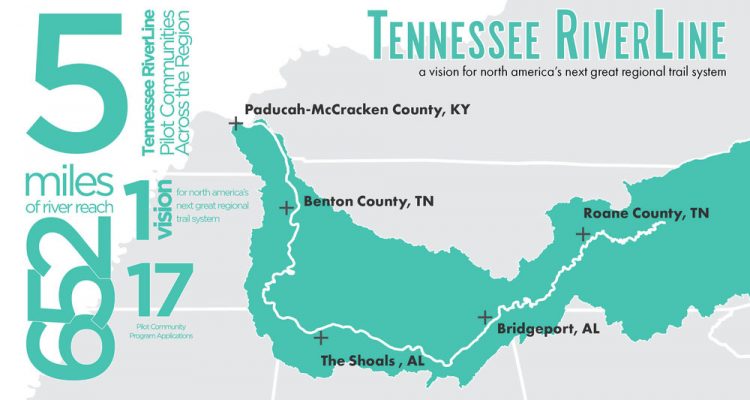Fifteen communities have been accepted to the inaugural cohort of the Tennessee RiverTowns Program as part of the Tennessee RiverLine, North America’s next great regional trail system. This transformative initiative is led by the University of Tennessee, Knoxville, in collaboration with the Tennessee RiverLine Partnership.
The program is a three-stage initiative that cultivates collaboration among river communities around the Tennessee RiverLine, envisioned as a continuous system of paddling, hiking and biking experiences along the Tennessee River’s 652-mile reach.
Participating communities will benefit from economic development and entrepreneurship opportunities, quality of life amenities, and increased access to river experiences that improve public health and stewardship of natural resources. In the third stage of the program, communities will earn the official designation of a Tennessee RiverTown as part of the Tennessee RiverLine.
For the inaugural cohort, the partnership received 22 applications representing more than 936,000 community members. Criteria for selection included a demonstrated understanding of the Tennessee RiverLine vision and its guiding principles, as well local partnerships necessary to sustain an applicant’s participation in the Program. Any Tennessee River community can apply for future cohorts.
The following 15 communities were selected to continue in the process:
- Bridgeport, Alabama
- Decatur, Alabama
- Guntersville, Alabama
- Huntsville, Alabama
- The Shoals, Alabama
- Benton County, Tennessee
- Clifton, Tennessee
- Hardin County, Tennessee
- Knoxville, Tennessee
- Loudon County, Tennessee
- South Pittsburg, Tennessee
- Stewart County, Tennessee
- Roane County, Tennessee
- Calvert City, Kentucky
- Paducah–McCracken County, Kentucky
“Tennessee River communities are the beating heart of the Tennessee RiverLine,” said Tennessee RiverLine Partnership Director Brad Collett, an associate professor in UT’s Herbert College of Agriculture and College of Architecture and Design. “We are excited to begin collaborating with such a diverse group of communities through the Tennessee RiverTowns Program as we seek to unlock the river’s latent potentials for the benefit of generations of the region’s residents and visitors.”
Communities that were unable to apply this year can apply during future enrollment periods beginning in summer 2021. Those interested in learning more can visit the program’s web page.
The program follows the overwhelming interest received in summer 2019 through the Tennessee RiverLine Pilot Community Program. Five pilot communities were selected to share feedback and ideas on the Tennessee RiverLine vision and to begin the process of becoming part of the Tennessee RiverLine, and these five communities are members of the first RiverTowns cohort.
Called North America’s next great regional trail system, the Tennessee RiverLine originated in 2016 in UT’s School of Landscape Architecture, housed jointly within the College of Architecture and Design and the Herbert College of Agriculture. Today it is administrated by the Tennessee RiverLine Partnership with ongoing strong financial support from UT and the Tennessee Valley Authority.
The Tennessee RiverLine Partnership was founded as a diverse group of river advocates, including UT, TVA, the National Park Service’s Rivers, Trails, and Conservation Assistance Program, and several other organizations and agencies, to achieve the Tennessee RiverLine vision.
Today is another historic day for the Tennessee RiverLine and our supporters! We’re excited to announce that 15 communities across the region have been accepted to the inaugural cohort of the Tennessee RiverTowns Program and are beginning their journeys as part of the Tennessee RiverLine.
Tennessee River communities are the beating heart of the Tennessee RiverLine, and the Tennessee RiverTowns Program is our shared path to achieve this transformative vision. Participating communities will benefit from economic development and entrepreneurship opportunities, quality of life amenities and increased access to river experiences that improve public health and stewardship of natural resources.

